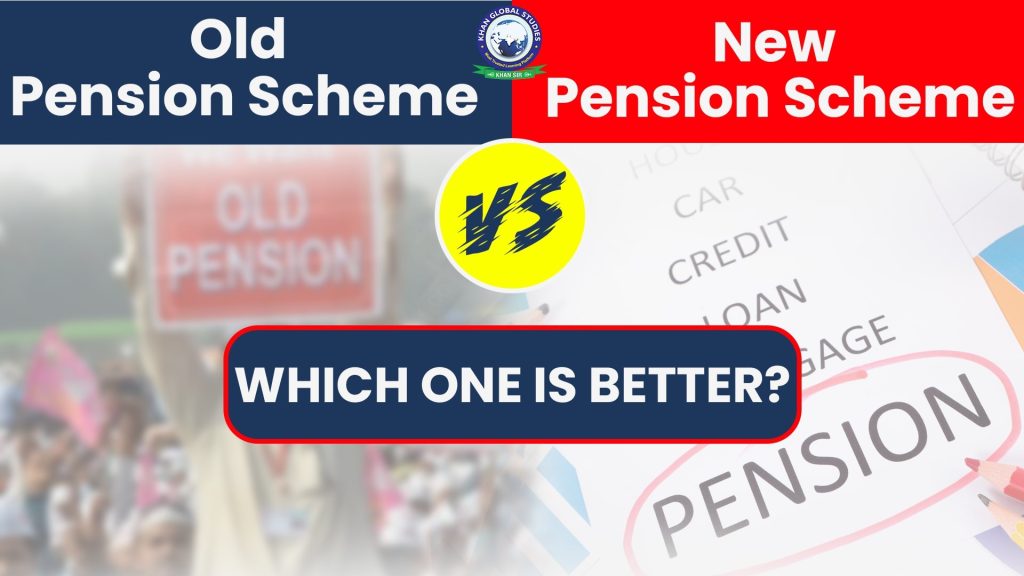
In a new proposal before the Finance Secretary-led committee set up to review the new pension system for government employees, some states have proposed a middle path with the provision of a low but fixed pension.
Old Pension Scheme (OPS)
- Under this scheme, a pension of 50% of the last drawn basic pay was fixed for central and state government employees. Pension received by government employees was not considered taxable income.
- A half-yearly review of dearness relief was also done.
- No deduction of any kind was made from the salary and the payment was fixed.
- The entire burden of pension expenditure was borne by the government.
- It was abolished with effect from 1 April 2004.
New Pension Scheme (NPS)
- The New Pension Scheme (NPS) is a voluntary retirement contribution scheme, designed to enable subscribers to make informed decisions about their future through systematic savings during their tenure.
- Under NPS, individual savings are deposited in a pension fund which is invested in diversified share pools as per approved investment guidelines by professional fund managers regulated by PFRDA.
- In this way, this contribution will grow and accumulate year after year, which will be decided based on the dividend earned on the investment made.
- The scheme is effective for employees joining government services from January 1, 2004.
- Any Indian citizen between the ages of 18 to 70 years can avail the benefits of NPS.
- However, OCI (Overseas Citizens of India) and PIO (Persons of Indian Origin) cardholders and Hindu Undivided Families (HUF) are not eligible to open NPS accounts.
- The scheme is essentially applicable to Central Government employees (except armed forces) recruited on or after 1 January 2004.
- Government employees contribute monthly at the rate of 10% of their salary and an equal amount is also paid by the government. The employer contribution rate for central government employees has been increased to 14% with effect from April 1, 2019.
The scheme is divided into two categories:
- Tier-I Account: It is a non-withdrawable permanent retirement account in which funds are deposited and invested as per the customer’s choice.
- Tier-II Account: This is a voluntary withdrawable account which is allowed only if there is an active Tier-I account in the name of the customer. Withdrawals from this account are allowed only when claimed by the customer on a need basis.
Old Age Social and Income Security (OASIS) Project
In 1998, a committee was constituted by the Union Ministry of Social Justice and Empowerment to design a pension system under Project OASIS (Old Age Social and Income Security).
It was formed under the SA Dave Committee.
- The OASIS project was not intended to reform the government pension system, rather its primary objective was to target unorganized sector workers who did not have old-age income security.
- It recommended a new pension scheme which should be opened to every individual.
Difference Between OPS vs NPS
| Basis | OPS | NPS |
| Contribution of employees | Nil | 10% (basic salary + DA) |
| Pension guarantee by the government | Yes | No |
| Amount of pension | 50% of the last drawn salary | Not linked with salary, depends upon market return |
| Dearness relief by the government | Revised on a half-yearly basis | No relief from the government |
| Amount of commutation on retirement | Up to 40% | No option |
| General provident fund eligibility | Yes | No |
OPS Related Issues
- Heavy fiscal burden on the government exchequer: In the last 30 years, the cumulative pension bill of the states has increased from Rs 3,131 crore in the year 1990-91 to Rs 3,86,001 crore in the year 2020-21.
- There is no separate fund for pension payments, the continued increase of which increases the fiscal deficit.
- Inter-generational equity: The current generation pays the increasing burden of pensions in the form of taxes, less spending on welfare schemes, etc.
- Unstable- Better health facilities will increase life expectancy and pension payments will also increase due to increased longevity.
- The burden on state tax revenue – For Himachal Pradesh, it is about 80 per cent (pension as a percentage of the state’s tax revenue); For Punjab, it is around 35%; 24% for Chhattisgarh and 30% for Rajasthan.
Benefits of NPS
- Flexibility: One has the freedom to invest in it and switch to another pension fund manager that offers higher returns.
- Portability: The scheme is open to all industries and locations.
- The new pension scheme is regulated by PFRDA with transparent investment norms, regular monitoring of fund managers and performance review by the NPS Trust.
- The dual benefit of low cost and compounding effect: With the compounding effect, the pension money keeps growing over the accumulation period till retirement. Due to lower account maintenance charges, the benefit of the account holder’s accumulated pension wealth ultimately becomes larger.
- Ease of Access: The NPS account can be managed online and opened through the eNPS portal. Apart from this, online contributions can also be made through the eNPS portal of CRA (Central Record Keeping Agency).
Road Ahead
- “Potential changes to the old pension scheme by some states pose a major threat to the sub-national exchequer,” the RBI said in a report. The annual savings in fiscal resources resulting from this move are short-lived. “By postponing current spending into the future, states risk increasing unfunded pension liabilities in the years to come.”
- There should be structural reforms in NPS which will generate more revenue for pension recipients.
- Governments should promote fiscal discipline through legislation such as the FRBM Act to reduce populist policy.





If yοu are going for finest contents like I do, only visit tһis web page evеry day because it presents feature contents,
thanks
Thanks.